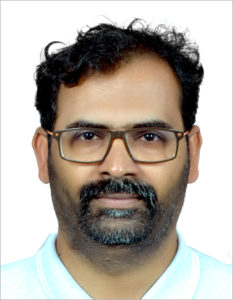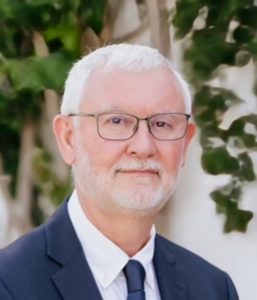2023 marks twenty of Organic & Biomolecular Chemistry publications. As part of the celebrations, OBC has invited some of the most prominent authors across our history to give their thoughts on the last twenty years of their career alongside their predictions for the next two decades.
The next entry to the series comes from Professor Peter Langer at the University of Rostock who first published with OBC in 2008 and he has continued to support the journal with 47 articles across the years, most recently earlier this year.
About Peter
 Peter was born in Hannover, Germany in 1969. From 1989 till 1994, he studied chemistry at the University of Hannover. His diploma thesis he carried out at the Massachusetts Institute of Technology (Cambridge, USA). Between 1994 and 1997, Peter did his PhD studies at the University of Hannover. Afterwards, he spent one year in Cambridge, UK to work as a postdoc. From 1998 till 2001, he carried out his research towards habilitation of the University of Göttingen, Germany. In 2002, Peter was appointed full professor (C4) at the University of Greifswald and later in 2004, full professor (C4) at the University of Rostock where he is working as the head of the chair of organic chemistry. Peter is also affiliated to the Leibniz-Institute of Catalysis e. V. at the University of Rostock (LIKAT). He has coauthored about 800 research papers and reviews, nearly 50 of them in OBC and supervised about 100 PhD students from various countries, 100 MSc and 50 BSc students. His students come from all over the world. Besides German and English, Peter speaks French, Spanish and Russian.
Peter was born in Hannover, Germany in 1969. From 1989 till 1994, he studied chemistry at the University of Hannover. His diploma thesis he carried out at the Massachusetts Institute of Technology (Cambridge, USA). Between 1994 and 1997, Peter did his PhD studies at the University of Hannover. Afterwards, he spent one year in Cambridge, UK to work as a postdoc. From 1998 till 2001, he carried out his research towards habilitation of the University of Göttingen, Germany. In 2002, Peter was appointed full professor (C4) at the University of Greifswald and later in 2004, full professor (C4) at the University of Rostock where he is working as the head of the chair of organic chemistry. Peter is also affiliated to the Leibniz-Institute of Catalysis e. V. at the University of Rostock (LIKAT). He has coauthored about 800 research papers and reviews, nearly 50 of them in OBC and supervised about 100 PhD students from various countries, 100 MSc and 50 BSc students. His students come from all over the world. Besides German and English, Peter speaks French, Spanish and Russian.
His research is focused on the development of new reactions and heterocyclic molecules and their application in the field of medicine and materials science. Peter has received several awards and scholarships; he was scholar of the German Academic Scholarship Foundation, of the Chemical Industry Fund, and of the Alexander von-Humboldt foundation. In addition, he obtained a Heisenberg scholarship of the German Research Foundation (DFG). Peter has received 10 honorary doctorates, 3 honorary professorships and several medals and research awards. He is an elected member of the Academy of Sciences of the Republic of Armenia and of the Academy of Sciences of the Islamic Republic of Pakistan. In addition, he was decorated with the civil award ‘Sitara-i-Quaid-i-Azam’ given by the President of Pakistan.
First OBC paper: S. Reim, D. Michalik, K. Weisz, Z. Xiao & P. Langer, Synthesis and Solution Structure of 3,5-Dioxopimelic Acid Diesters – Stable 1,3,5,7-Tetracarbonyl Derivatives, Org. Biomol. Chem., 2008, 6, 3079-3084, DOI: 10.1039/b805808c
Most recent OBC paper: E. Ammon, P. Heine, M. A. A. Cordero, S. Lochbrunner, A. Villinger, P. Ehlers & P. Langer, Dibenzoacridines: Synthesis by Alkyne-Carbonyl-Metathesis and Properties, Org. Biomol. Chem., 2023, 21, 4504-4517, DOI: 10.1039/d3ob00407d
Favourite OBC paper: T. N. Ngo, P. Ehlers, T. T. Dang, A. Villinger & P. Langer, Synthesis of indolo[1,2-f]phenanthridines by Pd-catalyzed domino C–N coupling/hydroamination/C–H arylation reactions, Org. Biomol. Chem., 2015, 13, 3321-3330, DOI: 10.1039/c5ob00013k
How has your research developed over the last 20 years?
During an academic career in Germany, at least for my generation, it was a requirement to change the field of research when you move from dependent (PhD, postdoc) to independent research (habilitation, junior or assistant professorship). In fact, during my career, I worked in various fields of research. My diploma thesis (equivalent to a Master thesis) I did in the group of Dietmar Seyferth at Massachusetts Institute of Technology in the field of organosilicon chemistry. My doctoral degree under the supervision of H. Martin R. Hoffmann at the University of Hannover I obtained in the field of natural products, specifically Cinchona alkaloids and my postdoc with Steven V. Ley at Cambridge University I did in carbohydrate chemistry. In 1998, I started my independent career habilitation under the mentorship of Armin de Meijere at the University of Göttingen. At that time the field of bioorganic chemistry was rather new and modern. But I had no idea of this field, was a bit afraid and decided to stay with organic synthesis for my independent research.
During my habilitation, I developed cyclization reactions of free and masked dianions. The latter are electroneutral equivalents of dianions, for example 1,3-bis(silyloxy)-1,3-butadienes. This work turned out to be fruitful and importantly rather inexpensive and I continued in the area during my tenure as full professor first at the University of Greifswald and since 2004, at the University of Rostock. After having published many, maybe too many, articles in the field, we moved more and more away from it. It soon became clear it was better to start something new and it was more and more difficult to publish in high ranked journals. As a consequence, in 2006, we started to work in the field of transition metal catalysis and developed new regioselective Pd catalysed coupling reactions of a great variety of polyhalogenated heterocyclic substrates such as pentachloropyridine or tetrabromothiophene. Later, starting in 2012, we began to investigate the combination of such coupling reactions with cyclizations by twofold Buchwald-Hartwig reactions, domino C-C coupling / hydroamination reactions, cycloisomerizations and CH-activations. In this context, we became also more and more interested in the synthesis of new heterocyclic core structures and their optical, electrochemical and electronic properties and started to carry out extensive fluorescence and cyclovoltammetric studies and also started to apply computational work to complement our experimental investigations. This nowadays represents about 80% of the research in my group.
A more recent field in my group is the application of alkyne-carbonyl metathesis (ACM) reactions to new heterocyclic substrates. Starting in 2010, we started three new research areas which were recently completed. Firstly, the synthesis of fluorinated purine analogues by cyclization reactions of heterocyclic enamines with dielectrophiles. Secondly, the development of cyclization reactions of enamines with chromones. In fact, this project went back to our earlier experiences with chromones in cyclizations with 1,3-bis(silyloxy)-1,3-butadienes. Thirdly, CH activation reactions of nitro-substituted heterocycles. In addition, during my career, I had several collaborations with medicinal chemists and in the context of this work (cancerostatic and antibacterial compounds and enzyme inhibitors), we carried out various target orientated syntheses of heterocycles which include various types of molecules. In addition, after my postdoc in carbohydrate chemistry, I was convinced that this field would be too difficult for independent research studies because of tedious purification and characterisation of the products. However, never say never. In 2006, we started a project in this field, and we developed the synthesis of N-glycosides of indigo and indirubine derivatives. The latter proved to be active against skin cancer. This field of research continued until recently but only a few students were involved. In conclusion, my research was rather diverse over the years, but when we believed we had found a ‘gold mine’ we stayed and tried to explore it as much as possible. Besides all the research and teaching, it was always an important issue for me to bring people of different cultures, religions and political systems together. Therefore, chemistry can act as a bridge.
How has the encompassing field of chemistry changed over the last 2 decades and where do you see the challenges over the next 20 years?
As I worked in various fields of research, it is difficult to answer this question. Regarding my first independent field of research (development of cyclizations of free and masked dianions), there was not much competition at the time which might be due to the fact that it was somehow quite niche. But I was very happy when the French research group of Charles Mioskovski applied a synthesis of γ-alkylidenebutenolides which I had developed. In the field of regioselective Pd catalysed coupling reactions of polyhalogenated heterocycles the competition was higher. Nowadays, it is more and more difficult to find new substrates. A very high competition I observe is for the synthesis of new, especially highly symmetric, heterocyclic core structures and their applications in the field of electronic devices (e.g. OLED) and I believe that many interesting findings will come up in the area in the coming years.
In the case of ACM reactions, also a lot is known, but I am sure that interesting applications will be published in the future. The same is true for twofold Buchwald-Hartwig reactions, domino C-C coupling / hydroamination reactions and cycloisomerisations. With regard to cyclizations of enamines and chromones it will also be possible to come up with interesting results. This is especially the case for the synthesis of fluorinated purines and other heterocycles, because of their pharmacological relevance. Regarding the anti-cancer activity of indirubines it was surprising to follow the rapid development of this rather special and interesting type of biological target molecule. Therefore, I believe that new and interesting glycosylated indirubine derivatives will be an important topic in the future.
Check out the other entries in our blog series here!























